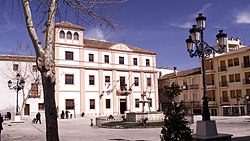
The Roman Catholic Diocese of Condom was a French bishopric based in Condom from 1317 to 1801.

Krbava is a historical region located in Mountainous Croatia and a former Catholic bishopric (1185–1460), precursor of the diocese of Modruš and present Latin titular see.
Berissa, also spelled Berisa, Verisa, or Verissa, was a city in the late Roman province of Pontus Polemoniacus, in Asia Minor, which Kiepert and W. M. Ramsay have identified with the modern village of Baulus, 25 kilometres south-west of Tokat.

Oschiri is a comune (municipality) and former bishopric in the Province of Sassari in the Italian region Sardinia, located about 170 kilometres (110 mi) north of Cagliari and about 40 kilometres (25 mi) southwest of Olbia.

The Diocese of Guadix is a Latin suffragan diocese of the Catholic Church in the ecclesiastical province of Granada in Andalusia, southern Spain and a Latin titular bishopric under its Ancient name of Acci. Its cathedral episcopal see is Nuestra Señora de la Anunciación, dedicated to Our Lady of the Annunciation, in the city of Guadix, administrative province of Granada. It was commenced in 1710, on the site occupied by the principal mosque, and completed in 1796.
The Roman Catholic Diocese of Bacău was a diocese of the Latin Church in Moldavia.
Zygris was a small town in the Roman province of Marmarica, a province also known as Libya Inferior. It was in the eastern part of this region, which some geographers considered a separate area, called Libycus Nomus, distinct from both Marmarica and Aegyptus. It may have been located at Zaviet-El-Chammas in modern Egypt. Diderot's Encyclopedia gave Solonet as its modern name.
The Diocese of Castro di Sardegna was a Roman Catholic diocese located in the town of Oschiri in the Province of Sassari in the Italian region of Sardinia. In 1503, it was suppressed along with the Diocese of Bisarcio and the Diocese of Ottana to form the Diocese of Alghero.
Taborenta, Mauretania Caesariensis was a Berber civitas (town) and bishopric in Roman North Africa. It disappeared during the 7th century, and is assumed to be near Saida in modern Algeria. It was nominally restored in 1933 as a titular see.
Buleliana was a civitas (town) and bishopric in Roman North Africa and remains a Latin Catholic titular see.
Botriana is a locality and archaeological site in Tunisia

The Diocese of Gisipa is a home suppressed and titular see of the Roman Catholic Church, suffragan of the Archdiocese of Carthage.

Zarna was a Roman town of the Roman Empire during late antiquity. An exact location for the town has been lost to history, although that it was in the Roman province of Africa Proconsolare means it must have been in northern Tunisia.
Dystis was a city and bishopric in Roman Libya, which remains a Latin Catholic titular see.

Culusi was a Roman town of the Roman province of Africa Proconsolare, located near Carthage. It is also known as Culcitana or Culsitana. The city is tentatively identified with ruins in the suburbs of Tunisia.
Henchir-Bladia is an archaeological site and locality in southern Tunisia. The stone ruins are tentatively associated with Bladia, a civitas of the Roman province of Byzacena during the Roman Empire. It was a Catholic bishopric.

The Diocese of Bennefa is a home suppressed and titular see of the Roman Catholic Church. Bennefa, identifiable with Oglet-Khefifa in modern Tunisia, is an ancient civitas of the Roman province of Byzacena. and a seat of an ancient Christian episcopal see. The diocese was mentioned by Augustine of Hippo.

Crepedula was an ancient Roman–Berber civitas in the province of Byzacena in Africa Proconsularis. It was located in modern Tunisia. The town was also the seat of a Catholic diocese.
The diocese of Bacanaria is a suppressed and titular see of the Roman Catholic Church.

Nabala was an ancient Roman–Berber diocese in the province of Mauretania Caesariensis, located in present-day Algeria. No ancient bishops are known from the diocese, although it was vacant in 484; similarly, the seat of the bishopric remains unknown. Today, Nabala survives as a suppressed and titular bishopric of the Roman Catholic Church. The current holder of the see is Lucilo B. Quiambao, a former bishop of Legazpi.











